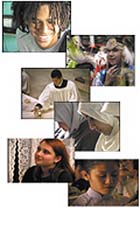
What Do You Believe? 2002
Distributed by Good Docs
A Film by Sarah Feinbloom
Directed by Sarah Feinbloom
VHS, color, 50 min.
Jr. High - Adult
Religious Studies, Adolescence
Date Entered: 11/09/2018
Reviewed by Charles J. Greenberg, Cushing/Whitney Medical Library, Yale UniversityContemporary popular media typically portrays American teenagers as fashionable trend seekers, secularly motivated and consumed with perfecting either their beauty or wit. When religion makes an infrequent appearance in a teenage audience drama or comedy, the featured belief system is almost certainly drawn from generic Christian belief or moral commandments. Popular culture does not rise to the occasion in providing religious insight. To risk the introduction of an alternative belief system is to invite criticism from alienated audiences or advertisers.
In contrast to the homogenized theistic worldview of popular culture, the inspired production What Do You Believe? presents more than 20 articulate teenagers responding thoughtfully and candidly with opinions about their own spirituality. Six of the teens are featured in an extensive segment of interviewing and visual documentation, focusing on how they do or don’t incorporate their religious identity into school, home, and daily life in general. The individual biographies are separated by a consistent transition of several brief responses to a common theme, presented by other teens.
The featured subjects excel at reflective descriptions of their youthful spiritual journey and rituals, along with occasional doubts and disagreements with religious standards. The audience observes Anthony, a Catholic alter boy, credit his faith with shaping his values, though it genuinely bothers him that as he matures the role of religion in his life has diminished. A vivacious veiled Muslim girl, Masouza, explains her lifestyle conversion from teen rebel to the modest and self-respecting person she always wanted to be. A teen girl named Morgan introduces the viewer to formalized pagan beliefs, complete with rituals that build her confidence to believe in something. A teen from a bi-cultural Jewish-African American family, David, expresses great uncertainty about the power of prayer, yet is very comfortable with his Jewish friends. An Asian-American teen Buddhist, Carina, explains how her non-theistic belief in cause and effect does not affect her ability to get along with friends of other faiths and credits her own faith with allowing her to reach a higher state of mind. Finally, a Native American Crow tribe teen named Julius demonstrates the spiritual heritance of dance ceremonies handed down by many generations of his cultural family.
For all of the profiled teenagers, the influence of parental religious practice is overt, and parental approval and encouragement has provided the initial learning environment. At the same time, some of the teens have begun to question their religious identity and are uneasy in knowing how this might disappointment parents or close religious friends.
The well-edited audio and video production relies entirely on the ability to capture spontaneous words and actions of the teenage subjects. Introductory factual passages precede some interview segments. While the absence of narration would not help viewers with visual disabilities, the subjects’ own words clearly capture their perspective on faith, and I could easily imagine hearing the soundtrack as a radio feature.
Regardless of how strong the formal practice of religion remains at the end of each individual teen’s story, we are consistently confronted with articulate, optimistic, and inquisitive youth that are happy and self-confident, if not entirely sure how to integrate the tenets of their faith with the first romantic impulses they feel. Not a stereotype or trend seeker in sight.
Highly recommended for secondary and public library collections.